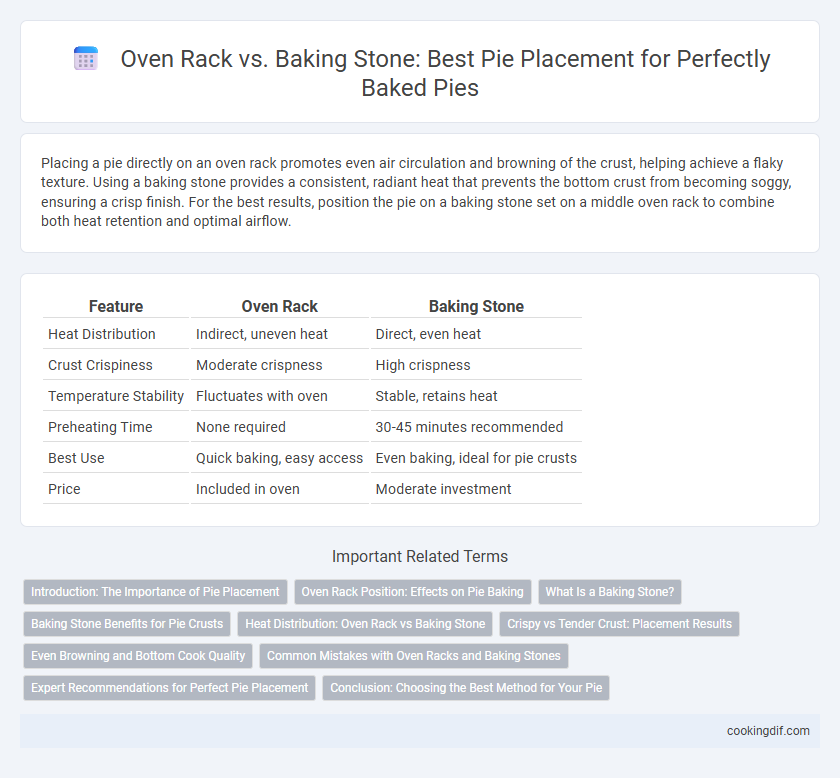Placing a pie directly on an oven rack promotes even air circulation and browning of the crust, helping achieve a flaky texture. Using a baking stone provides a consistent, radiant heat that prevents the bottom crust from becoming soggy, ensuring a crisp finish. For the best results, position the pie on a baking stone set on a middle oven rack to combine both heat retention and optimal airflow.
Table of Comparison
| Feature | Oven Rack | Baking Stone |
|---|---|---|
| Heat Distribution | Indirect, uneven heat | Direct, even heat |
| Crust Crispiness | Moderate crispness | High crispness |
| Temperature Stability | Fluctuates with oven | Stable, retains heat |
| Preheating Time | None required | 30-45 minutes recommended |
| Best Use | Quick baking, easy access | Even baking, ideal for pie crusts |
| Price | Included in oven | Moderate investment |
Introduction: The Importance of Pie Placement
Placing a pie on an oven rack allows hot air to circulate evenly, promoting uniform baking and a crisp crust. Using a baking stone retains and distributes heat consistently, ensuring the pie's bottom cooks fully without sogginess. Selecting between an oven rack and baking stone can significantly impact the texture and overall quality of the pie.
Oven Rack Position: Effects on Pie Baking
Placing a pie on the middle oven rack ensures even heat distribution, promoting a uniformly baked crust and filling. Positioning the pie too close to the bottom rack can result in a soggy or burnt bottom crust due to excessive direct heat. Conversely, placing it on the top rack increases the risk of over-browning or uneven cooking, making the middle rack optimal for consistent pie baking results.
What Is a Baking Stone?
A baking stone is a flat, heavy slab made from materials like ceramic, cordierite, or cast iron designed to evenly distribute heat in the oven. When placed on the oven rack, it absorbs and retains high temperatures, creating a stable cooking surface that helps produce a crispier pie crust. Using a baking stone instead of placing the pie directly on the oven rack prevents uneven baking and promotes consistent heat circulation for optimal pie results.
Baking Stone Benefits for Pie Crusts
Baking stones provide consistent, even heat distribution that enhances pie crust texture, resulting in a perfectly golden, crisp bottom. The stone absorbs and retains heat, preventing soggy crusts by drawing moisture away during baking. Compared to oven racks, baking stones help achieve superior heat retention, essential for flaky and well-cooked pie crusts.
Heat Distribution: Oven Rack vs Baking Stone
Oven racks provide direct airflow around the pie, promoting even heat distribution but may cause uneven browning on the bottom crust. Baking stones absorb and radiate heat uniformly, delivering consistent bottom crust crispness and preventing hot spots. Using a baking stone stabilizes oven temperature, resulting in a balanced and thoroughly cooked pie.
Crispy vs Tender Crust: Placement Results
Placing a pie directly on the oven rack promotes air circulation, resulting in a crispier crust due to better heat exposure and moisture evaporation. Using a baking stone provides even heat distribution, which helps achieve a tender, evenly baked crust by preventing hot spots and preserving moisture. For a balance of crispy and tender textures, preheating the baking stone and placing the pie on the rack ensures optimal crust development.
Even Browning and Bottom Cook Quality
Placing a pie directly on an oven rack promotes increased air circulation, resulting in evenly browned crusts but may risk uneven bottom cooking due to heat gaps. Using a baking stone provides consistent, radiant heat from below, enhancing thorough bottom crust cooking and preventing sogginess while maintaining balanced browning. For optimal results, a preheated baking stone ensures a crisp, golden bottom crust with uniform top browning, surpassing the oven rack's performance in heat distribution.
Common Mistakes with Oven Racks and Baking Stones
Common mistakes with oven racks include placing the pie too close to the heating element, resulting in uneven crust browning or burning. Using a baking stone without preheating it thoroughly often causes inconsistent heat distribution, leading to soggy or undercooked pie bottoms. Failing to adjust rack height or rotate the pie during baking can also compromise even cooking and crust texture.
Expert Recommendations for Perfect Pie Placement
Expert bakers recommend placing pies directly on the oven rack for optimal heat circulation, ensuring a crisp and evenly baked crust. Using a baking stone can provide consistent bottom heat, preventing soggy bottoms and promoting a golden, flaky texture. For perfect pie placement, preheat the baking stone thoroughly and slide the pie onto it, or position the pie on the middle rack if using an oven rack alone.
Conclusion: Choosing the Best Method for Your Pie
Placing the pie on an oven rack promotes even heat circulation, resulting in a crispier crust, while a baking stone provides consistent, radiant heat for a perfectly browned bottom. For pies with delicate fillings or time-sensitive baking, the oven rack offers better airflow and quicker baking times. Choose a baking stone if you aim for a uniformly cooked crust with enhanced texture, but rely on an oven rack when prioritizing faster baking and ventilation.
Oven rack vs Baking stone for pie placement Infographic

 cookingdif.com
cookingdif.com